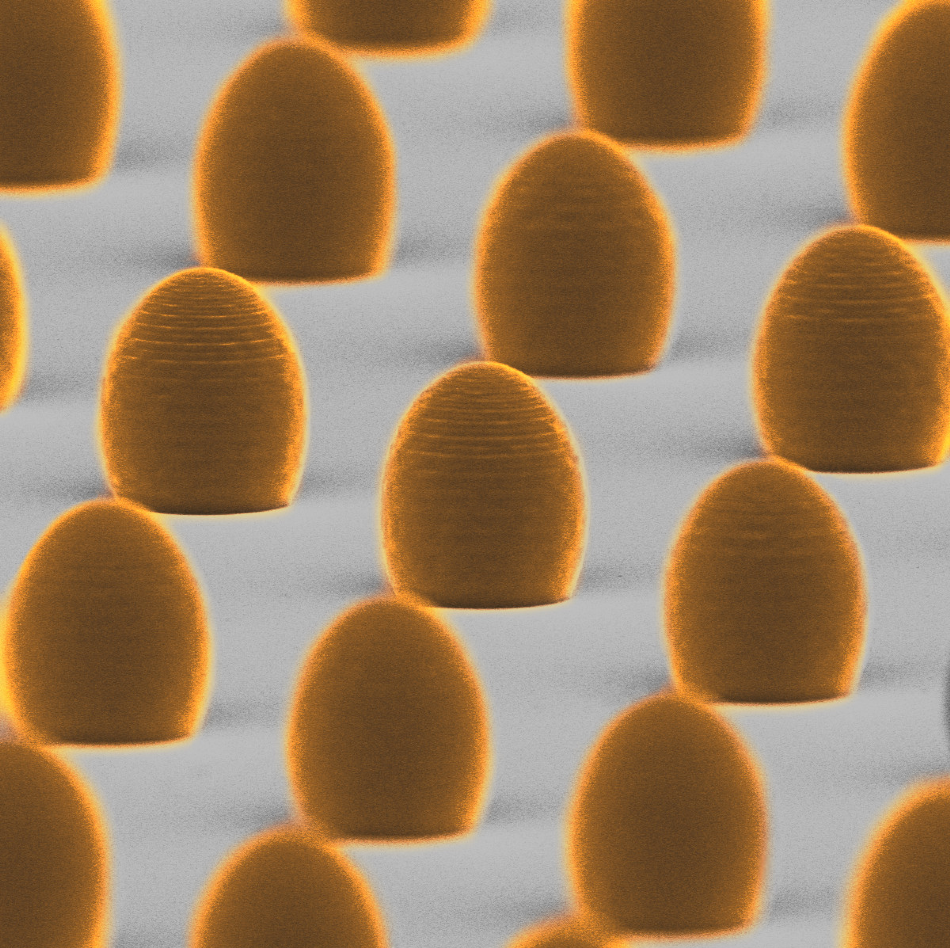May 14 2020
Researchers at the Faculty of Physics, University of Warsaw have demonstrated micrometre-sized 3D-printed aspherical microlenses which can replace bulky microscope objectives in spectroscopic measurements of single point-like light emitters (e.g. quantum dots or atomically thin 2D materials). The proposed microlenses increase the available working distance, i.e. the distance between the lens front and the sample surface, by over two orders of magnitude, and open up new perspectives for a wide class of optical experiments.
 Scanning electron microscope image of 3D-printed aspherical microlenses. Thanks to short printing time, it is possible to produce hundreds of such microlenses on one sample.
Scanning electron microscope image of 3D-printed aspherical microlenses. Thanks to short printing time, it is possible to produce hundreds of such microlenses on one sample.
Additive manufacturing is a technique in which the final three-dimensional object is produced by successively adding new layers of building material to those that have already been deposited. Recently, the commercially available 3D printers have been experiencing rapid development and so do the 3D-printers materials, including transparent media of high optical quality. These advancements open up new possibilities in many fields of science and technology including biology, medicine, metamaterials studies, robotics and micro-optics.
Researchers from the Faculty of Physics, University of Warsaw, Poland, have designed tiny lenses (with dimensions as small as a fraction of the human hair diameter) that can easily be manufactured by laser 3D printing technique on top of various materials, including fragile novel 2D graphene-like materials. The presented lenses increase the extraction of light emitted from semiconductor samples and reshape its outgoing part into an ultra-narrow beam. Thanks to this property, there is no longer a need for including a bulky microscope objective in the experimental setup when performing optical measurements of single nanometre-sized light emitters (like quantum dots), which up to now could not be avoided. A typical microscope objective used in such a study has roughly a handbreadth size, weights up to one pound (half a kilogram) and must be placed at a distance of about one-tenth of an inch (few millimetres) from the analysed sample. These impose significant limitations on many types of modern experiments, like measurements in pulsed high magnetic fields, at cryogenic temperatures or in microwave cavities, which on the other hand can easily be lifted by the presented lenses.
High speed of the 3D-printing technique makes it very easy to produce hundreds of microlenses on one sample. Arranging them into regular arrays provides a convenient coordinate system, which accurately specifies the location of a chosen nanoobject and allows for its multiple measurements in different laboratories all over the world. The invaluable opportunity of coming back to the same light emitter allows for much more time-efficient research and hypothesis testing. Specifically, one can entirely focus on designing and performing a new experiment on the nanoobject studied before, instead of carrying out a time-consuming investigation of thousands of other nanoobjects before eventually finding an analogue to the previous one.
The shape of the proposed microlenses can easily be adapted to the so-called 2.5D microfabrication technique. The objects satisfying its prerequisites can be produced over large-scale surfaces by pressing a patterned stamp against the layer of material they are supposed to be made of. The 2.5D fabrication protocol is especially attractive from the viewpoint of potential applications of the microlenses, as can be readily up-scaled which is an important factor in possible future industrial use.
Physics and Astronomy first appeared at the University of Warsaw in 1816, under the then Faculty of Philosophy. In 1825 the Astronomical Observatory was established. Currently, the Faculty of Physics' Institutes include Experimental Physics, Theoretical Physics, Geophysics, Department of Mathematical Methods and an Astronomical Observatory. The research covers almost all areas of modern physics, on scales from the quantum to the cosmological. The Faculty's research and teaching staff includes ca. 200 university teachers, of which 78 are employees with the title of professor. The Faculty of Physics, University of Warsaw, is attended by ca. 1000 students and more than 170 doctoral students.